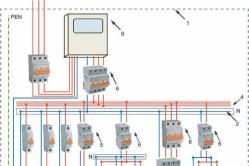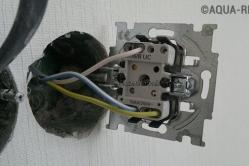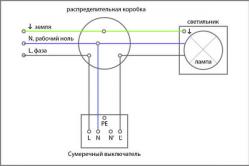Antipyretics for children are prescribed by a pediatrician. But there are emergency situations for fever when the child needs to be given medicine immediately. Then the parents take responsibility and use antipyretic drugs. What is allowed to give to infants? How can you bring down the temperature in older children? What medicines are the safest?
In the course of home improvement, it is constantly required to make holes in the wall for hanging lamps, clocks, shelves. In order not to damage the hidden cable with a perforator drill or a drill bit, you must first determine where it is laid.
An example of using a Bosch detector
According to the rules, electrical wiring is placed horizontally or vertically, but often this is done at the smallest distance.
In order to avoid trouble with the consequences of cable damage, it is advisable to always have a hidden wiring detector at hand, which is a non-contact tester or probe.

hidden wiring detector
Electric underfloor heating is now in vogue. If the wiring breaks inside it, a significant part of the heating elements will fail. Here, a tool is especially needed to find the place of the break so as not to open the entire system located in the screed or in the adhesive layer under the ceramic tiles.
Which to choose?
A simple probe can only find hidden wiring. The functionality of modern electronic devices is greatly expanded. With their help, you can distinguish a live wire from a de-energized wire, detect the presence of plastic, wood, non-ferrous metal or other types of masonry. Detection technologies are very different.
When choosing a device, you need to know for what purposes it may be needed, since the price depends on it. It is not necessary for a home master to buy an expensive multifunctional tool, which for the most part will lie idle.
Sometimes the phase is easy to find with an indicator screwdriver. You can also use a simple tester. It is not difficult to assemble such a device with your own hands.
Tools can be classified according to the following principles of operation:
- electrostatic;
- electromagnetic;
- metal detectors;
- combined.
Electrostatic indicator
The device captures electromagnetic radiation from electrical wiring that is energized. Most of the do-it-yourself detectors work on this principle.
In the absence of a consumer, the signal is very weak. If the depth of the wire is large, it may not be detected. If the registration sensitivity is low, it is affected by nearby devices or metal fittings in the wall.
It is impossible to find a wire under damp plaster. With all the shortcomings, the electrostatic indicator of hidden wiring is inexpensive and easy to use.

Using an indicator to detect hidden wiring
It is quite suitable for a dry wall in an apartment, but when working in a garage, bathhouse and other utility rooms, devices based on other principles of operation will be required.
Electromagnetic detector
The device features high wire detection accuracy, simple and easy handling. The device works well when the wire is under a load of at least 1 kW. With a weak current or its absence, the wiring cannot be detected.
More advanced models can even detect hidden "bugs" (eavesdropping devices), as well as determine the level of danger of electromagnetic radiation. The hidden wiring detector "Impulse" has such capabilities.
When switching operating modes, it is capable of:
- determine the location of the hidden source of electromagnetic radiation;
- establish the nature of the field (frequency measurement);
- give an audible signal when the radiation threshold is reached;
- set the direction of the field;
- store the measured signal.
metal detector
The device makes it possible to detect even de-energized wiring, but it also reacts to all metal objects. With the development of certain skills, it can be successfully worked with. The metal detector emits a magnetic field that changes as metal approaches. A whole group of metal detectors works on this principle.
Combined appliances
The most effective is the hybrid principle of operation, which combines different ways of finding wiring in the wall. The devices are intended for use by professionals and are expensive.
Their capabilities allow you to determine the presence of electrical wiring, its depth and the presence of voltage in it. The devices also allow you to detect foreign materials in the walls: plastic, wood, metal parts.
Advantages and disadvantages of devices with different operating principles
| Detector type | Advantages | Flaws |
|---|---|---|
| Electrostatic | 1. Easy and reliable detection. 2. Large coverage area. | 1. The need for voltage in the wiring. 2. Interference from metal elements on the walls and moisture. |
| Electromagnetic | 1. Reliability and ease of use. 2. High precision. 3. Availability of additional functions. | 1. The need for the wire to be under load. 2. High price. |
| metal detector | 1. Finds a dead wire. | 1. It is difficult to distinguish a wire from any metal. |
| Combined | 1. Different modes of operation. | 1. High price. |
The depth of detection and sensitivity of different models is different. A cheap or self-made tester may not detect the wire at great depths.
Other appliances
There are a lot of detectors of various types and purposes for sale, and it is important to choose the right one.
Convenient for use domestic device for searching for hidden wiring "Lis M". After the trace is detected, visual (LED) and sound indication (built-in emitter) is produced. The determined depth of control reaches 2 m.

Device "Fox M" for searching for hidden wiring
The DSL 8220s detector with moisture protection will help you find the wires of the mains, telephone, antenna cable under plaster, brick, drywall, plastic. The minimum operating temperature is +50C.
The Meet MS-158M tester has a price of 300-400 rubles. and searches for hidden wiring, metals, electromagnetic radiation, and also checks the grounding of devices and cable breaks.
The BOSCH GMS 120 detector has a wiring detection depth of 120 mm. At the same time, it finds the middle of the object with high accuracy. At the same time, the properties of the materials are indicated and the measurement result is presented on the display.
There are 3 detection modes, which also includes the search for metal. The tool is highly reliable, and many of the manufacturer's models are professional. Everything in them is thought out to the smallest detail, up to the presence of a hole in the body, through which a mark is made on the discovered section of the wall.
The only drawback is the high price - 4500 rubles. Other BOSCH models are also expensive.
You can buy a good detector "Black and Decker BDS200" made in China. It is relatively inexpensive (1300 rubles), quite reliable, can detect metals and search for hidden wiring at a depth of up to 50 mm.
The location of the cables in the walls is found using a device called "Woodpecker E121", which has 4 sensitivity ranges. It detects an electric field when the load in the conductor is not lower than 0.38 kW.
"Woodpecker" determines the phasing of electric meters without removing the cover with a seal, the health of the fuses, and also finds breaks. Professionals often use this device in their work. The Woodpecker E121 tool is often used to indicate live wires as a safe non-contact device.
Small-sized and high-precision hidden wiring finder - "Mastech". It can work with different materials and has the additional function of a metal detector.

Hidden wiring finder "Mastech"
The device contains a generator-transmitter connected to the wiring and a probe with which it is easily detected. In this case, it is not necessary to apply voltage to the wire, since the signal from the transmitter passes through it.
Often the characteristics of cheap models do not match their real capabilities.
Which is better?
Having determined a number of necessary functions of the device, you can proceed to the choice of model. Often you have to overpay for the brand. This is not always justified, so it is advisable to find out from experts which device is better.
If this is not possible, it remains to believe the guarantees of a reliable manufacturer that is recognized in the market.
The hidden wiring detector must be checked in the store. It is advisable to start mastering the device there, since you will have to do the search yourself. To do this, you need to find a visible wire plugged into the outlet.
Then you should make a test by searching for a conductor in the presence and absence of voltage and load, as well as at different distances from the device.
It should not be forgotten that the device is a non-contact tester. You can search for the wire by covering it with various objects: a board, a piece of plastic, ceramic tiles, etc.

Setting up the detector on the visible wire
This controls how the probe reacts to this. It is necessary that all the actions declared in the passport coincide with the real ones.
Only in this case, you can be sure that its quality corresponds to the cost. It is useful to make a comparison of a branded copy with a domestic device of a similar class in terms of the number of functions and characteristics.
The detector may have additional functions, for example, a laser tape measure, a level, a flashlight.
You should not take devices on the market, because you can buy a fake. It is better to contact a specialized store where you can require a certificate for the selected model.
How to use
Understanding the principle of operation of the device allows you to maximize its capabilities.
Setting
Before using the device, a test is made on an open wire that is energized. In this case, the antenna must be kept at different distances from the source.
Break in wiring
It is easy to find a break in the phase wire with your own hands. To do this, the device is moved along the conductor, while the place of signal termination will be damaged. With a neutral wire, the situation is more complicated. To find a break, it is grounded on one side, and on the other, the phase is connected through a resistance of 1-2 MΩ. The place of the break is found by moving the probe along the wire. You need to know what the load should be in order for the device to catch the signal.



